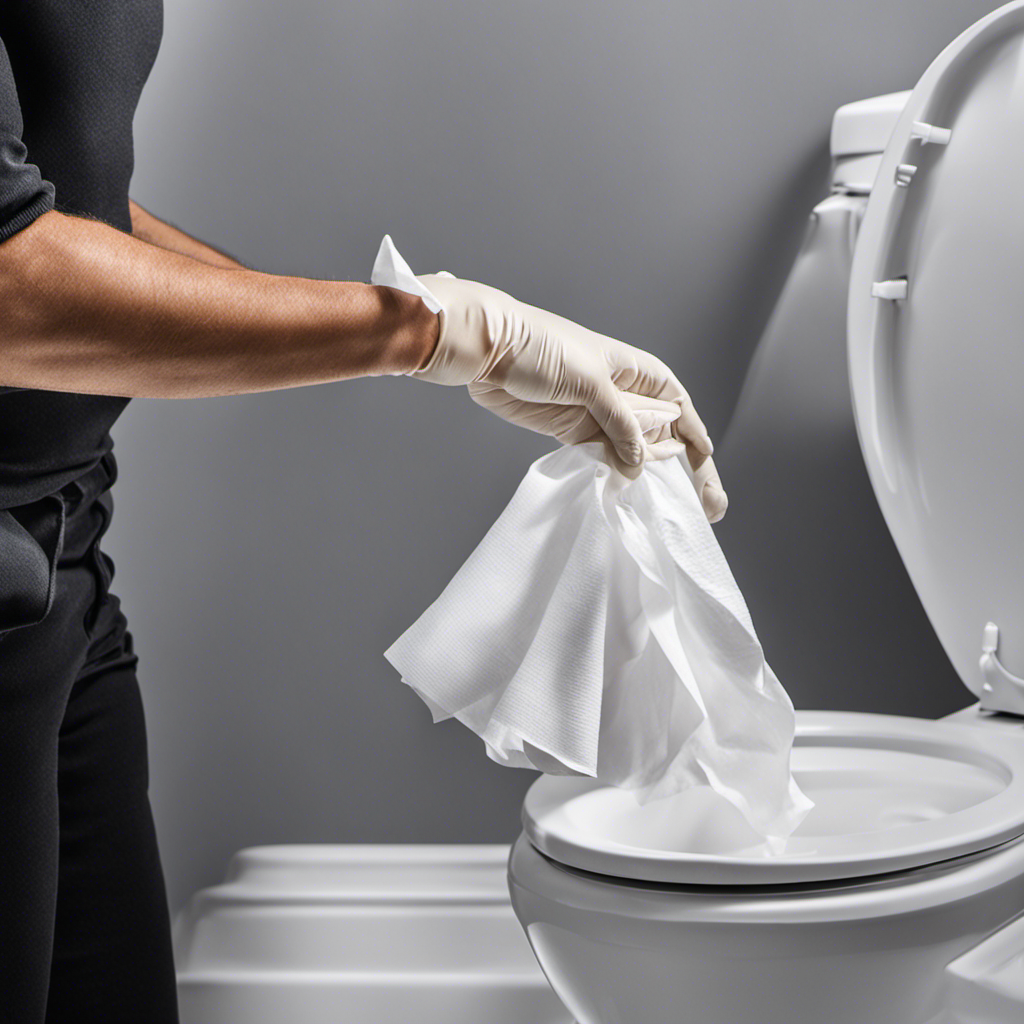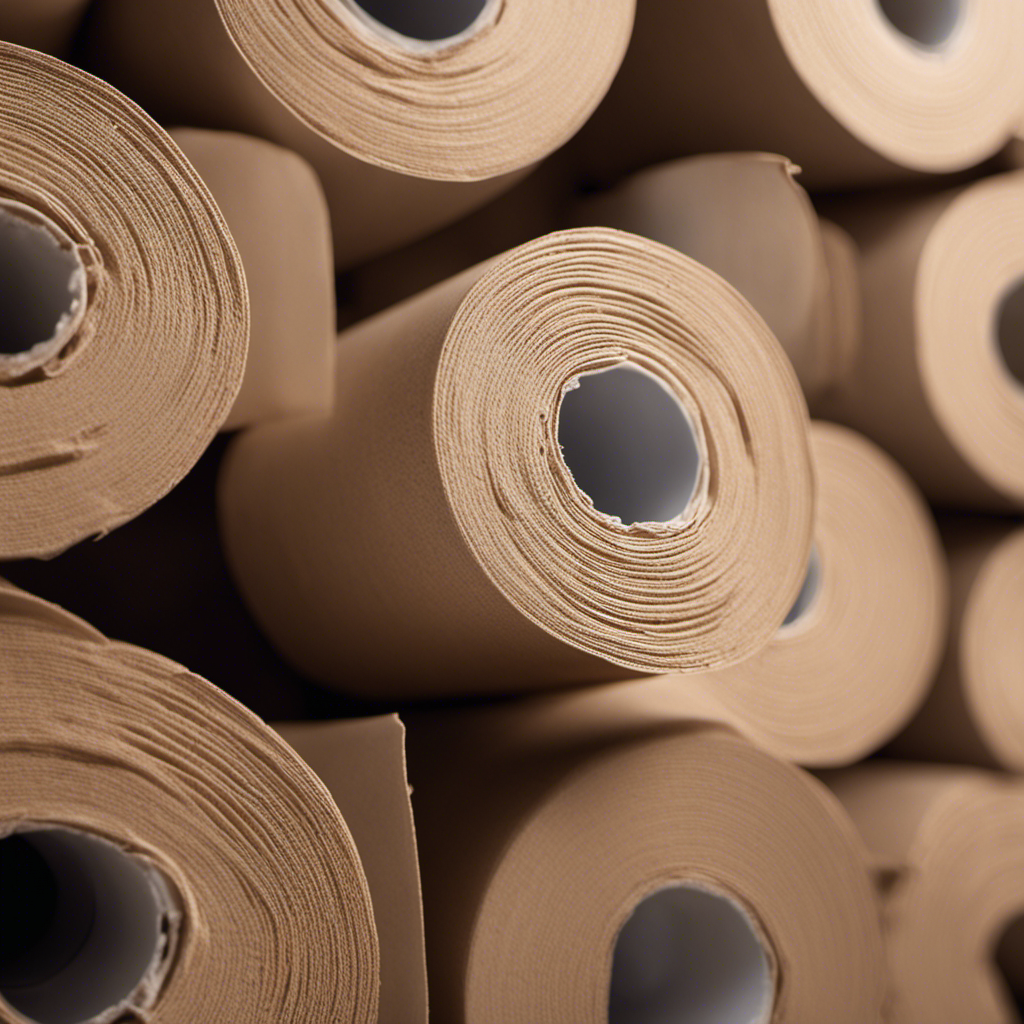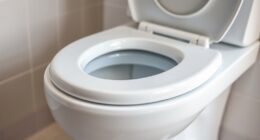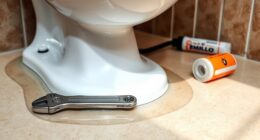Are you tired of dealing with a toilet that sweats excessively? Fed up with the constant puddles on your bathroom floor? Well, fear not, because we’ve got the solution for you!
In this article, we will guide you through the step-by-step process of stopping your toilet from sweating. From understanding the causes to implementing proper insulation techniques, adjusting water temperature, and using anti-sweat toilet tank liners, we’ve got all the expert advice you need to keep your toilet dry and hassle-free.
Key Takeaways
- Controlling humidity levels and improving ventilation in the bathroom can help prevent toilet sweating.
- Insulating the toilet tank and using a toilet tank liner can reduce condensation and sweating.
- Proper insulation and sealing gaps in the bathroom can prevent moisture issues and mold growth.
- Regular maintenance, such as adjusting water pressure and temperature, using a dehumidifier, and ensuring proper ventilation, can help prevent toilet sweating and maintain a dry and comfortable bathroom environment.
Understanding Toilet Sweating
To understand why your toilet is sweating, you need to know how condensation forms on the outside of the bowl. Condensation occurs when warm, moist air comes into contact with a cold surface. This can happen when the humidity levels in your bathroom are too high.
The moisture in the air condenses on the cooler surface of the toilet bowl, causing it to sweat. Understanding the condensation risks is crucial in finding a solution.
To prevent toilet sweating, you need to control the humidity levels in your bathroom. This can be done by using a dehumidifier or improving ventilation. Additionally, insulating the toilet tank can help keep the surface temperature higher, reducing the chances of condensation formation.
Identifying the Causes of Toilet Sweating
When it comes to understanding the causes of toilet sweating, there are three key points to consider: condensation and temperature, insulation and moisture, and ventilation and air circulation.
Condensation and temperature play a crucial role in the formation of sweat on the toilet tank and bowl.
Insulation and moisture levels in the bathroom can also contribute to this issue, as they affect the temperature and humidity in the space.
Lastly, proper ventilation and air circulation are essential in preventing toilet sweating, as they help to regulate the moisture levels and temperature in the bathroom.
Condensation and Temperature
The toilet sweats because it is too cold in the bathroom. To prevent condensation and regulate the temperature, you should consider the following:
- Increase the room temperature: Set the thermostat a few degrees higher to create a warmer environment.
- Use a space heater: Place a small heater in the bathroom to maintain a consistent temperature.
- Ventilate the bathroom: Open a window or turn on the exhaust fan to allow air circulation.
- Insulate the toilet tank: Wrap the tank with an insulating material to prevent cold surfaces.
- Install a toilet tank liner: These liners provide an extra layer of insulation to reduce condensation.
By implementing these measures, you can effectively prevent condensation and regulate the temperature in your bathroom, ensuring a sweat-free toilet.
Now, let’s delve into the next section about insulation and moisture.
Insulation and Moisture
If you’re experiencing moisture issues in your bathroom, insulating the walls and sealing any gaps can help prevent further problems. Moisture control is essential in maintaining a healthy and comfortable environment. Insulation effectiveness plays a crucial role in reducing condensation and preventing moisture buildup. By properly insulating your bathroom walls, you can create a barrier that helps regulate temperature and minimize the potential for moisture-related issues. Sealing any gaps or cracks will also prevent moisture from seeping in and causing damage. Here is a table that illustrates the importance of insulation in moisture control:
| Benefit of Insulation | Description |
|---|---|
| Reduces condensation | Insulation helps maintain a consistent temperature, reducing the likelihood of condensation forming on bathroom surfaces. |
| Prevents mold and mildew growth | Insulation acts as a barrier, preventing moisture from seeping into walls and creating an environment conducive to mold and mildew growth. |
| Improves energy efficiency | Insulation helps maintain a stable temperature, reducing the need for excessive heating or cooling and saving energy costs. |
Ventilation and Air Circulation
Properly maintained ventilation and good air circulation are essential for preventing moisture buildup in the bathroom. Without adequate ventilation, excess moisture can accumulate, leading to mold, mildew, and unpleasant odors.
To ensure effective ventilation and air circulation, consider the following techniques:
-
Install a ventilation system: A bathroom exhaust fan or a ventilation system with proper ductwork can effectively remove moist air from the bathroom.
-
Keep the bathroom door open: Leaving the bathroom door open allows for better air circulation and helps prevent moisture from getting trapped.
-
Open windows: If possible, open windows to increase the flow of fresh air and aid in the removal of moisture.
-
Use a dehumidifier: A dehumidifier can help remove excess moisture from the air, reducing the chances of moisture buildup.
-
Regularly clean and maintain the ventilation system: Clean the exhaust fan and check for any clogs or malfunctions to ensure proper air circulation.
Proper Insulation Techniques for Preventing Toilet Sweating
When it comes to preventing condensation on toilets and addressing the issue of toilet sweating, it is important to consider the use of proper insulation materials.
Insulation plays a crucial role in maintaining the temperature and preventing the formation of condensation on toilet tanks and bowls.
Insulation Materials for Sweating
You can use foam insulation to prevent your toilet from sweating. Insulation options for preventing moisture buildup include:
-
Fiberglass Insulation: This type of insulation is commonly used in homes and is effective in preventing condensation on the toilet tank.
-
Rubber Insulation: This material provides excellent moisture resistance and is easy to install. It can be cut to fit the specific dimensions of your toilet tank.
-
Closed-Cell Foam Insulation: This type of insulation has a higher density and is more rigid, making it ideal for preventing sweating on the toilet tank and pipes.
-
Reflective Insulation: This material reflects heat and blocks moisture from forming on the toilet surface.
-
Spray Foam Insulation: This insulation is applied as a liquid and expands to fill any gaps or voids, providing a seamless barrier against moisture.
Preventing Condensation on Toilets
To prevent condensation on toilets, it’s important to choose the right insulation material.
When it comes to insulating techniques, there are a few options you can consider. One effective method is to use foam insulation. This material creates a barrier that prevents warm air from coming into contact with the cold toilet tank, reducing the chances of condensation forming.
Another option is to use reflective insulation, which can be attached to the inside of the toilet tank to reflect the heat back into the tank. Additionally, you can also insulate the water supply line to further minimize condensation.
By insulating these areas properly, you can significantly reduce the occurrence of toilet sweating.
Now, let’s move on to the next step, which involves adjusting the water temperature to minimize toilet sweating.
Adjusting the Water Temperature to Minimize Toilet Sweating
Adjusting the water temperature can help minimize toilet sweating. By making a few simple changes, you can prevent condensation from forming on your toilet and keep your bathroom dry. Here are some steps you can take to adjust the water temperature effectively:
-
Lower the water pressure: High water pressure can contribute to toilet sweating. Adjust the water pressure to a moderate level to reduce the occurrence of condensation.
-
Insulate the tank: Adding insulation to the toilet tank can help regulate the temperature and prevent cold surfaces that lead to sweating.
-
Adjust the water temperature: Lowering the water temperature can minimize the temperature difference between the cold toilet tank and the warm bathroom environment.
-
Consider a mixing valve: Installing a mixing valve allows you to mix hot and cold water, helping to maintain a more consistent temperature in the toilet tank.
-
Seek professional advice: If you’re unsure about adjusting the water temperature or need assistance with insulation, consult a plumber for expert guidance.
Using Anti-Sweat Toilet Tank Liners
Using anti-sweat toilet tank liners can help prevent condensation buildup on your toilet and maintain a dry bathroom.
These liners are specifically designed to insulate the toilet tank, reducing the temperature difference between the cold water inside and the warm air in the bathroom. By doing so, they minimize the formation of sweat or condensation on the tank’s exterior.
Anti-sweat toilet tank liners are easy to install and are available in various sizes to fit different toilet models. They are typically made of foam or rubber materials that provide effective insulation.
These anti-sweat toilet products are a cost-effective solution to combat toilet sweating and can significantly improve the overall comfort and cleanliness of your bathroom.
Now, let’s move on to some regular maintenance tips to prevent toilet sweating.
Regular Maintenance Tips to Prevent Toilet Sweating
Regular maintenance is key to preventing condensation buildup in your bathroom and ensuring a dry and comfortable environment. Here are some troubleshooting techniques to help you keep your toilet from sweating:
-
Insulate the tank: Use a foam insulating kit to cover the inside of the tank. This will help regulate the temperature and prevent moisture buildup.
-
Check the water temperature: If the water entering the toilet tank is too cold, it can cause sweating. Adjust the temperature of the water heater to a warmer setting.
-
Use a dehumidifier: Excess humidity in the bathroom can contribute to condensation. Using a dehumidifier can help reduce moisture in the air.
-
Ensure proper ventilation: Make sure your bathroom has adequate ventilation, such as a fan or window, to allow for airflow and prevent the buildup of moisture.
-
Regularly clean the toilet: Keep the toilet clean and free from any debris that may contribute to sweating.
Conclusion
So there you have it, dear reader, the ultimate guide on how to stop a toilet from sweating. Armed with the knowledge of understanding toilet sweating and identifying its causes, you can now take action to prevent this pesky problem.
Whether it’s through proper insulation techniques, adjusting the water temperature, or using anti-sweat toilet tank liners, there are plenty of solutions at your disposal. Just remember to regularly maintain your toilet, because what could be more thrilling than preventing a sweaty toilet?
Happy plumbing!










